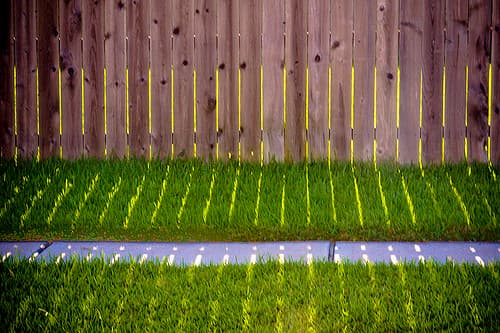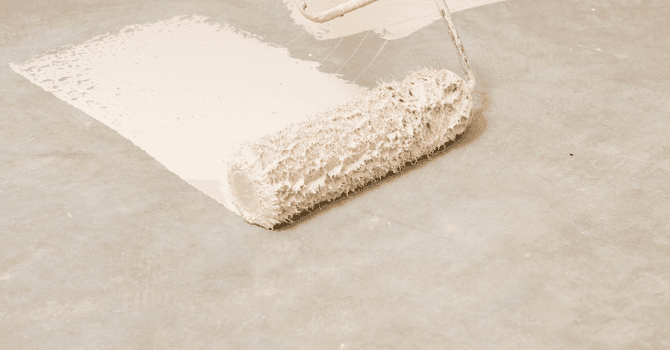
Painting or staining your fence will prolong the wood’s durability while adding a bit of flair to your backyard. After all, who wants to feel boxed in by the walls marking the boundaries of your property?
Preparing Your Fence for a Fresh Coat of Paint
First of all, check the anchors, nails, and screws holding the fence to ensure that the framework is solid and the planks are in good condition.
Should the wood be smudged, dirty, chipped, damaged, or mouldy, address these issues first with wood cleaners, brighteners, surface regenerators, and strippers. For example, to remove the old paint or stain layer, sand the top layer with 80-100 grit sandpaper.
You can also pressure wash the surface while allowing 24 to 48 hours for the wood to fully dry afterward. After stripping or repairing a fence, or even if it is new, clean it with a broom or water hose, and allow 24 hours to pass for the wood to dry.

Photo: David Hilowitz
Now the surface is ready! If there is already a coating, check for proper adhesion. Josée-Ann Cloutier of Benjamin Moore for CAA Quebec suggests doing two tests. First, apply a few drops of water to various surface areas, and if the water is quickly absorbed, proceed accordingly. Otherwise, dab a layer on a small, inconspicuous section, and let it dry for 24 hours. Then, firmly press the end of an adhesive strip on the freshly coated surface and remove it in one swift motion. If the paint does not peel off, there will be no need to strip the old paint.
In some cases, applying a primer could be beneficial. Yet, as mentioned by Cloutier, you can paint a stained surface but you cannot stain a painted surface.
How to Paint a Wood Fence?
Set a weekend aside if you want to paint your fence and at the same time check your balcony, patio, or garden furniture to see if these wooden structures need a new coat of paint too.
Materials
With a little help, you may be able to paint everything at once and with the same paint to create a uniform look. Buying paint in bulk will help you save money. Also, make sure that the weather forecast does not call for rain in your area. However, do not paint in direct sunlight as this will affect the adhesion of the product and the uniformity of the colour. The ambient and surface temperatures should be between 10 to 32 degrees Celsius, and the humidity should be between 40% and 70% for 24 hours.

Photo: Max pixel
Steps
You can start as soon as your wooden outdoor structures are dry. Normally, when painting garden furniture, you start at the bottom, moving upward to the legs, and then to the top, but with a fence, it is best to paint it one plank at a time: Paint the whole plank and then the piece of wood that connects one plank to the other. Proceed meticulously as fence and patio furniture extremities that are left outside all year long tend to absorb humidity.
When working, let the paint sink into the wood cracks and knots to later avoid seepage that could lead to fibres splitting, coating problems, and mildew. To reduce any streaking, run the paintbrush in the direction of the grain and cover the entire length of the board in one motion.
“Using a paintbrush is the best way to apply any coating to a deck. To obtain better results, use a paintbrush with natural bristles for oil-based coatings and one with synthetic fibres (nylon) for acrylic-type coatings. If you choose to apply a coating with a roller, I suggest using a paintbrush to paint the sides to ensure that the coating is properly absorbed,” said Josée-Ann Cloutier of Benjamin Moore at CAA Quebec.
Keep in mind that a paintbrush can reach those hard-to-reach areas such as cracks, knots, and nail and screw holes; a roller saves time when painting a façade, and a paint sprayer is even faster. To maintain colour consistency, pour the new paint into the leftover quarter-full paint can then shake it. Two coats of stain or paint are recommended.
Note that for a patio, the surface must be left to dry for at least 48 hours before safely walking on it, and for all wood structures, wait at least 30 days before washing for the coating to take.
Painting a Fence during the Fall
While you may make the most of your backyard during the summertime, it is preferable to proceed with any changes to your outdoor layout a year ahead of time. Therefore, fall tends to be the ideal time to plant a tree, put in a pool, and paint the fence bordering your yard. However, the fresh ambient air should not be below 10 degrees Celsius, because cold paint is thicker.
Cold paint is harder to apply and may ripple on the surface, therefore it is better to warm the paint than to thin it. Also, if dew condenses on fresh paint, it will result in a more or less matte finish. Therefore, we suggest painting during the warmest time of the day—in the afternoon—so that the paint has time to set before the dew falls.

Photo: Karnikin
How to Stain a Fence?
To protect wood structures that remain outside, use stain rather than paint as the former will easily be absorbed by rough surfaces like wood. However, the steps previously mentioned in regards to applying paint should be followed to stain a wood fence.
Forget about using a roller! It will not saturate the wood sufficiently. Instead, opt for natural bristle paintbrushes for alkyd-based stains or synthetic fibre paintbrushes for latex paint. There are three types of wood finishes available on the market: A translucent finish, which is used as a protective layer, a semi-transparent finish that colours without masking the wood grain, and an opaque finish that gives a paint-like appearance.
"For cedar or sequoia wood, apply a primer first to block any leaching, which is a natural brown substance released by these species," Benjamin Moore’s product specialist Robert Bernier advised La Presse. Whereas, with newly treated wood, it is best to wait a year to let the protective finish naturally wear off. "Otherwise, the waterproof glaze will repel the stain," said Anne Legault, the sales manager at Home Depot for Eastern Canada, to La Presse.
If you do not want to paint, creosote is an alternative to varnish. This is a liquid substance with which you can permeate wood to render it rot-resistant, thereby keeping it from rotting. Creosote stain is a wood preparation with an added colour pigment. Creosote will ooze through paints like tar, so avoid priming or painting it. It will be a waste of time!
Get 3 renovation quotes for your fence painting or staining project
RenoQuotes.com can help you get quotes for your fence painting project. By submitting your project, we’ll put you in contact with top-rated contractors. Fill in the form on the homepage (it only takes a few minutes), and you will get estimates from trusted professionals.
Dial 1-844 828-1588 to speak with one of our customer service representatives.
Looking for something else?
Related articles
The latest industry news, interviews, technologies, and resources.

Editorial Team
•23 Jul 2025
Anyone who has taken on the task of painting a ceiling knows how hard it can be... Frustration can continue until the very end of the process when you finally take a look at the finished job and realize that marks or light spots appear on your ceiling.

Karine Dutemple
•05 Dec 2025
With summer at our feet, one can't help but quickly take out their lounge chairs and outdoor patio furniture to make the most out of the nice weather. While you may be barbecue ready, your patio, on the other hand, might need a bit more TLC!

Editorial Team
•25 Jul 2025
Epoxy concrete surface paint is a sought-after option for those looking to protect their floors while also rendering them aesthetically pleasing. With its winning combination made up of high-end durability, the ability to withstand chemical products, an easy-to-clean factor, and a glossy finish, this solution is increasingly used in homes, businesses, and public spaces.

Léa Plourde-Archer
•08 Feb 2025
The contract has been signed, the work has started and all of a sudden, the contractor is asking you to pay. This leads to a lot of questions. Does the contractor have the right to make this request? Can he stop working if you refuse to pay?

Editorial Team
•25 Jul 2025
Are you looking to add to your current living space? Whether it’s a solarium or a sunroom, they’re both great options. The question is, what’s the difference between the two?